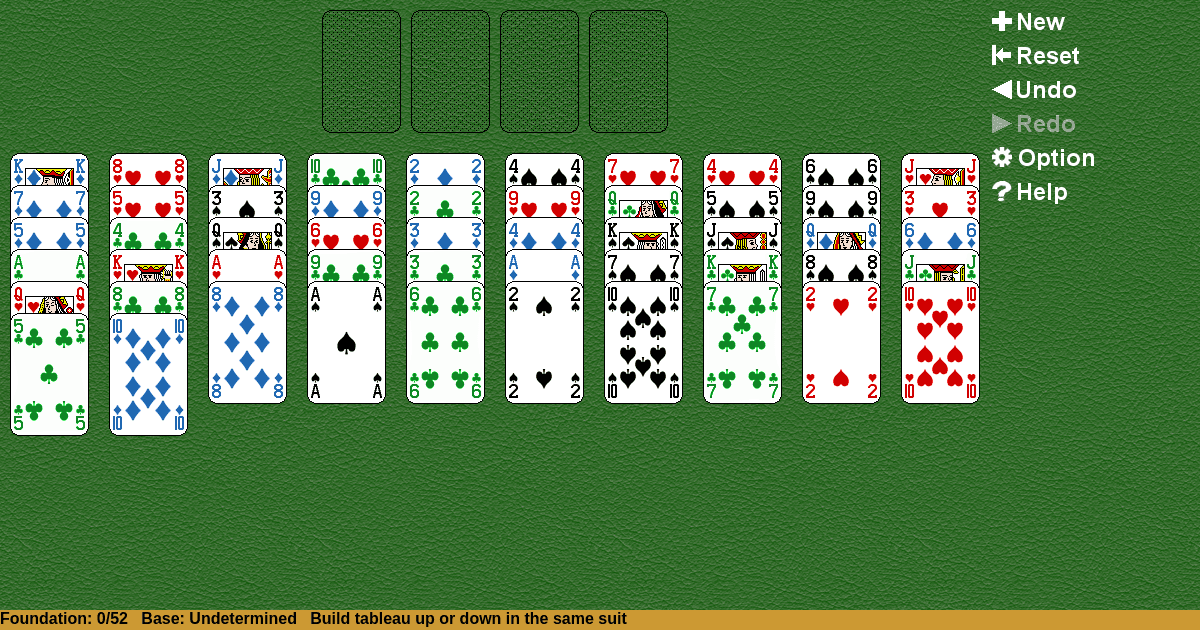Chessboard
Home |
How to play |
FAQ |
About
How to play Chessboard?
Game Objective:
The primary goal in Chessboard Solitaire is to move all cards from the tableau onto the foundation piles, building each foundation up in suit from a selected starting rank until each foundation contains a complete sequence of thirteen cards.
Setup & Layout:
- Deck: Use a standard 52-card deck; no jokers are included.
- Tableau Arrangement: Shuffle the deck and deal all cards face-up into ten tableau piles. Each pile fans sideways so all cards are visible.
- The tableau is arranged in two columns (wings) of five piles each.
- The top pile of each wing contains six cards; the remaining piles contain five cards each.
- Foundations: Place four empty foundation piles vertically between the two wings of tableau piles.
- Card Orientation: All cards in the tableau are dealt face-up. No cards are hidden at any time.
Key Play Areas:
- Tableau: Ten piles where cards are initially dealt and manipulated.
- Foundations: Four piles where cards are built up in suit to complete the game.
Chessboard Solitaire Rules:
- Card Movement:
- Only the top card of each tableau pile is available for play.
- Cards may be built on tableau piles either up or down in suit, with circular building allowed (e.g., Ace can follow King and vice versa).
- Building Sequences:
- Building is strictly by suit, either ascending or descending.
- Circular building: After King comes Ace, and after Ace comes King.
- Moving to Foundations:
- Any available card may be played onto any empty foundation pile to start it.
- After the first card is placed on a foundation, the remaining three foundations must be started with cards of the same rank as the first foundation card.
- Foundations are then built up in suit, with circular building (Ace follows King).
- Empty Tableau Piles:
- Any available card may be moved to fill an empty tableau pile.
Gameplay:
- On each turn, the player may:
- Move the top card from any tableau pile onto another tableau pile, following the up/down in suit rule.
- Move the top card from any tableau pile to a foundation, following foundation rules.
- Move any available card to fill an empty tableau pile.
- No hidden cards: All cards are always visible, so every move is fully informed.
- No stock or reserve piles: All cards are in play from the start.
- If a player cannot make any legal moves (i.e., cannot build on tableau or move to foundations), the game is unwinnable and must be restarted.
Winning & Losing Conditions:
- Winning: The game is won when all cards have been moved to the four foundation piles, each built up in suit from the starting rank to complete a full sequence of thirteen cards.
- Losing/Unwinnable State: The game is lost or unwinnable if no legal moves remain and not all cards have been moved to the foundations.
Special Rules & Edge Cases:
- Filling Empty Tableau Piles: Any available card (top card from any tableau pile) may be moved to fill an empty tableau pile.
- Foundation Starting Rank: The rank of the first card played onto a foundation determines the starting rank for all four foundations; all must start with cards of this rank.
- Circular Building: Both tableau and foundation building allow circular sequences (Ace may be built onto King and vice versa).
- No Stock/Reserve: There are no additional piles; all cards are dealt and visible from the start.
- No Restrictions on Suit Movement: Only suit matters for building; color is not relevant.
- No redeal: Once the initial setup is complete, there are no redeals or additional deals during play.
Definitions:
- Tableau: The main play area consisting of ten piles where cards are initially dealt and manipulated.
- Foundation: The target piles where cards are built up in suit to win the game.
- Circular Building: The ability to continue sequences from King to Ace and Ace to King without interruption.
This guide is based on official and reputable sources, ensuring semantic precision and clarity for optimal gameplay understanding.

Solitaire Collection
About Chessboard
Rate (Chessboard)
4.7 / 5
1,916 votes



























































